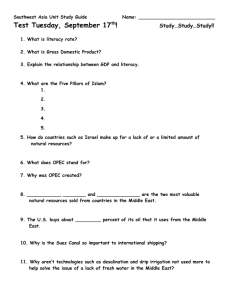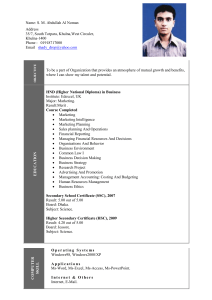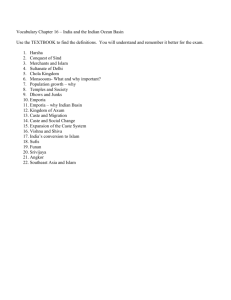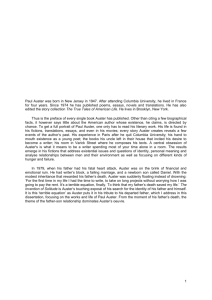Click to View Paper on Anti-Muslim 'Cultural Racism'
advertisement
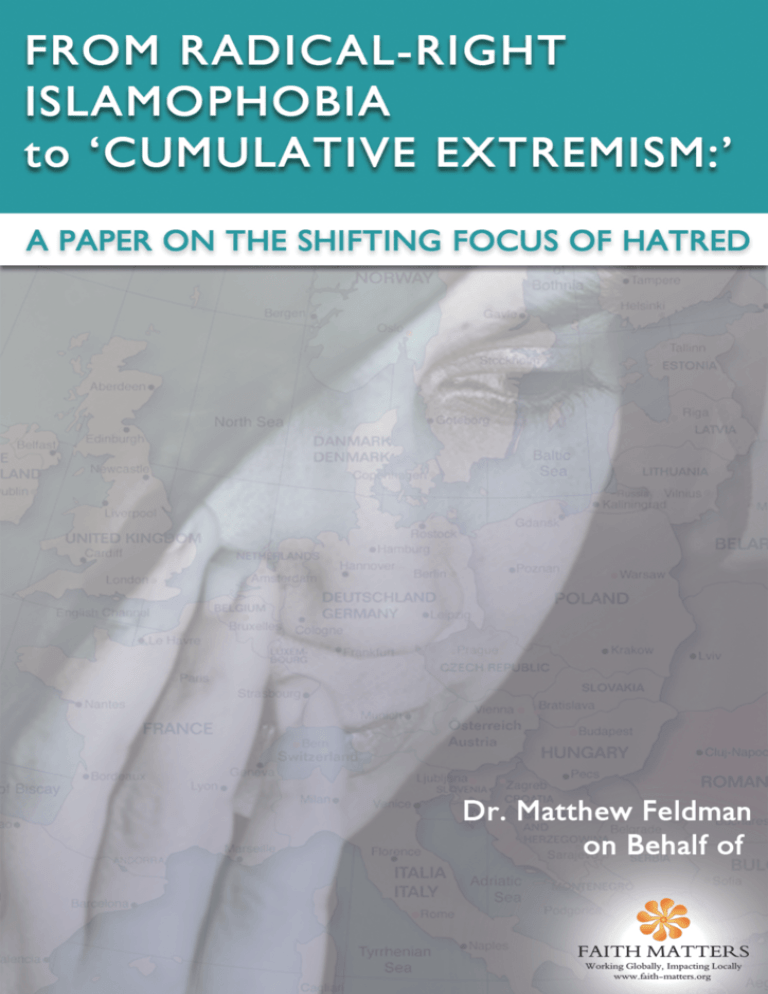
From Radical-Right Islamophobia to ‘Cumulative Extremism’ Matthew Feldman 1 An important development in radical right activism this century – albeit sharing many similarities with demonised communities in the past – is, without doubt, the turn toward anti-Muslim politics. In the aftermath of mass-casualty terrorist attacks by Islamist militants attacks in the US on 11 September 2001; Madrid on 11 March 2004; and the UK on 7 July 2005, the emergence of a potent anti-Muslim politics has offered a crucial hook for a new generation of radical right politicians to hang an extremist agenda – one palpable in some sections of the mainstream media and wider public. In focussing upon the British case, a good example to start with is from the British National Party’s (hereafter BNP) current chairman Nick Griffin. In a lecture directed to the ‘backstage’ of the movement in 2005, he urged activists to turn away from an unhelpful antiSemitism and embrace anti-Muslim politics in an attempt at populist, electoralfriendly campaigning: […] in real politics in the real world, one’s proper choice of enemy is a group who you gain a worthwhile level of extra support by identifying, who you have a realistic chance of beating, and whose defeat will take you the furthest towards your goal. With millions of our people desperately and very reasonably worried by the spread of Islam and its adherents, and with the mass media ... playing ‘Islamophobic’ messages like a scratched CD, the proper choice of enemy needn’t be left to rocket scientists. 2 Griffin was trying to distance the BNP from much of its earlier rhetoric, echoing the anti-Semitism between the wars, so closely identified with ‘classical’ fascist movements like Nazism or the Oswald Mosley’s British Union of Fascists. In the place of ‘traditional’ Judeophobic prejudice, the 1 radical right has increasingly turned toward a ‘culturalist racism’ of implacable difference and intractable conflict with European Muslims – one in many ways playing on the same kinds of populist phobias, casual discrimination and demonization as anti-Semitism did a century ago. This cultural prejudice assumes that all Muslims are indirectly responsible for the actions of an extremist minority centring on the notion that Islam (not just jihadi Islamist violence, which all citizens of goodwill naturally oppose) is an ‘other’ that cannot be accommodated within liberal democratic Europe. As Liz Fekete notes, wider media narratives about Muslims in Europe and the US are a central cause of this growth: Around much of Europe, the media is launching its own ‘witch‐hunts’ of Muslims who display symptoms of ‘unacceptable behaviour’ as enunciated by terrorism laws. No other communities are placed under the microscope, constantly questioned about their personal beliefs, their ‘foreign allegiances’, as the Muslim communities of Europe. It’s former Tory minister, Norman Tebbit’s cricket test gone mad. 3 Without doubt, over the last generation the more successful radical right ideologues and movements have been acutely sensitive to shifts in the political and cultural landscape. As limited Anglophone research has correspondingly emaphasised, nowhere has this been more visible than in the embrace of populist anti-Muslim politics over the last decade. 4 Aided by the aforementioned jihadi Islamist attacks on one hand, and by longer-term demographic change on the other, Europe and the US have played witness to degrees of collective prejudice and scapegoating wholly at variance with democratic progress toward equality and individual agency. This new intolerance– as the far-right has quickly grasped, and some Anglophone literature has registered of late – would be considered unacceptable if leveled against other historical ‘out-groups’: Jews, Irish or black people and so on (not 2 including Roma and Sinti peoples, who still suffer from collective stereotyping and discrimination to a shameful degree 5). Clearly fanning these flames are windier sections of the reactionary media, thus providing an issue able to be shared by ideologues and talking heads of all right-wing stamps – ‘paleo-‘, ‘neo- ‘far-‘ and ‘extreme’ alike. In perfect storm of populist prejudice, radical Islamist propaganda and right-wing cultural racism have together attempted to turn the notion of a ‘clash of civilizations’ into a kind of self-fulfilling prophecy. Deploying this phrase as a warning following the late-1980’s ‘Rushdie Affair’ – several years before Samuel Huntington’s well-known thesis about intractable conflicts between seven all-to-monolithic cultures – Bernard Lewis observed in his 1990 “The Roots of Muslim Rage”: This is no less than a clash of civilizations—the perhaps irrational but surely historic reaction of an ancient rival against our Judeo-Christian heritage, our secular present, and the worldwide expansion of both. It is crucially important that we on our side should not be provoked into an equally historic but also equally irrational reaction against that rival. 6 Yet several decades earlier, interestingly, an Anglican missionary named Basil Matthew’s used just this terminology in the much same cautious and careful manner. In a 1926 survey of the interwar Islamic ‘cultural renaissance’, entitled Young Islam on Trek: A Study in the Clash of Civilisations, Matthew’s appealed to ‘places of learning’ and the ‘wise enthusiasm of Christian men and women in Europe and America’. Through these, he predicted – save ‘an irremediable catastrophe of race-war produced by the madness of men’ – with some justification and optimism that: 3 Almost alone among all the ferments and forces at work to-day in the Moslem world they make not for a clash but for a blending; not for explosion and catastrophe, but for seed-sowing and growth and harvest. 7 Another voice between the wars, the Student Christian Movement’s W. Wilson Cash, similarly hoped that Islam would fulfil a new purpose in the world by a fresh emphasis upon the spiritual rather than the material, the religious instead of the political. Islam once made a great contribution to the culture of the West. The West in turn has made a similar contribution to Islam during the past fifty years, in awakening the Moslem people and in helping to create the present renaissance. The greatest need of the world to-day is for men of goodwill in all religions, who will fight for a spiritual basis to life against the new material paganism of the age, and in this Islam would play a noble part. Practicing Christians like Matthews and Cash had high hopes for the development of intercultural, and specifically interfaith, understandings and exchanges between a predominately Christian European and Muslim Arab and South Asian lands. The latter, in fact, concluded his Christendom and Islam: Their Contacts and Cultures Down the Centuries with a far more positive, if no less relevant, than is usually encountered today: Islam and Christianity have been for centuries sundered by hatreds, misunderstandings, and conflicts. A more careful survey of this period of history, however, reveals the hidden forces of spirituality in religion, the growth of civilization, the development of art and literature, and contributions from one religion to the other which have transcended wars, crusades and conflicts. We ask ourselves whether we are to continue to accept the position of old antagonisms which have divided the two peoples or whether circumstances to-day do not point to a more excellent way. 8 If it is hard to maintain the same optimism seventy-five years later in Europe and the US, surely the last generation of increased Islamist terrorism and anti-Muslim politics have played no small part. It may even be that opposing extremes rely upon each other to validate their shared notion of a ‘clash of civilizations’. From this perspective Roger Eatwell has usefully detected a link between the rhetoric of radical right activists and jihadi Islamists contributing to a ‘cumulative extremism’, whereby ‘one form of 4 extremism can feed off and magnify other forms.’ 9 In this way, the intertwined extremes from opposing illiberal camps seek to radicalize otherwise liberaldemocratic populaces rejecting both political violence and collective scapegoating – in all its forms – in favor of the clashing of supposedly hostile and monolithic civilizations. The most violent voice in this yet in this process of ‘cumulative extremism’ has certainly been Anders Behring Breivik, whose attempt to start a ‘European Civil War’ culminating with the end of Islam in Europe led to the deaths of 77 Norwegian innocents, mostly children, on 22 July 2011. 10 Writing for the New York Review of Books in the wake of Breivik’s terrorist bombing and mass shootings, Malise Ruthven stressed that his anti-Muslim views are ‘shared by many on the right and some in Europe’s liberal mainstream.’ Ruthven’s article, furthermore, highlights several of the wider similarities shared between both opposing, in some ways co-dependent, extremisms: Just as al-Qaeda represents an extreme, activist variant of political views held by a much wider constituency of Muslim radicals, most of whom would never consider crossing the boundary between thinking and action, so Breivik (judging from his manifesto) holds a broad range of positions common to what might be called the “counter-jihadist” or “paranoid right.” This is represented—among others—by Robert Spencer, Daniel Pipes, and Pamela Geller in the US, the controversial Dutch legislator Geert Wilders, and Bat Ye’or and Melanie Phillips in Britain. All these writers—most of whom have denounced the Utøya massacre in the most unequivocal terms—subscribe to variants of the thesis that Europe is sleepwalking into cultural disaster or (in the case of Phillips) enabling Islamist terrorists to gain a foothold. 11 For the radical right, this has become a signature issue. With the exception of a remaining hardcore of ‘traditional’ biological racists tending toward varying shades of white supremacism, the different manifestations of the radical right – social movements, electoral parties, and, importantly, interconnected websites – have turned toward anti-Muslim prejudice as a core strategy for 5 populist mobilization. A final example must suffice here, again drawn from the British case, as a microcosm of the way in which anti-Muslim rhetoric quickly circulates amongst the various shades of the illiberal right – not least, increasingly, online. Consider the case of a February 2012 speech delivered by Paul Weston, chairman of the British Freedom Party. Launched only eighteen months earlier, the BFP was seeking funding and visibility ahead of the UK’s May 2012 local elections. This placed Paul Weston on a tour of the eastern US, delivering speeches and attempting to find sympathetic allies during Winter 2012, including one largely representative talk entitled “Turning Britain into Lebanon”. Fully signed up to the ‘clash of civilizations’ thesis, Weston further warned of a ‘slide into civil war, tit for tat atrocities becoming progressively more vicious, before the entire country goes the way of Lebanon, or more recently Yugoslavia, which of course fractured along racial, tribal and religious lines.’ Weston was referring, of course, to an assumed, monolithic Islamic faith he considered ‘worse than Nazism’ that was acting within, and against, Britain – as apparently revealed by the ‘constant news about Mosques selling literature calling for the overthrow of Britain’s democracy, the murder of British Jews and homosexuals, the subjugation of the non-Muslim infidel and the desire to install a global Islamic caliphate.’ Weston then concluded: I am going to fight for Britain, but there is no guarantee that Britain and Europe can be saved, and if we go, and America goes shortly thereafter, then so goes Western Civilisation — the most humane, moral and decent civilisation in the history of mankind — to be replaced by Islam, the most barbaric, illiberal and totalitarian force of pathological cruelty that can only take the Western world back to the dark ages. Quite aside from offering a paradigmatic instance of fifth column discourse – 6 in this case, using the language of liberal democracy to advance anti-Muslim prejudice – perhaps just as revealing is the context for Weston’s lecture. This, in turn, may be divided into two parts. In the first instance, Weston’s lecture was originally filmed and presented at the apartment of Laurence Auster, cousin of the famous writer Paul and host of the ‘paleo-conservative’ website and blog, View from the Right. The latter, a kind twenty-first century John Birch Society for the online generation, essentially opposes multiculturalism in favor of return to ‘traditionalist’ conservative values in the US – extending to, as noted by Auster’s epigraph for his September 2008 online collection, “What to do about Islam”, ‘proposals for removing jihad and sharia supporters from America, restricting or prohibiting the practice of Islam in America, and containing and isolating Islam from the rest of the world, the policy I call Separationism’. More recent blog entries have extended this religious hatred to discussions on the usefulness of nuclear attacks against Mecca and Medina and the potential necessity of killing Muslims in the west following the outbreak of ‘civil war’. 12 Still more generally, in the years both before and since Auster’s particular attempts at a ‘nostalgic’ segregationism has extended beyond cultural prejudice toward Muslims to unreconstructed religious racism toward black Americans, as revealed by blog titles such as “What sets blacks off: anything or nothing”; “What have blacks contributed to our civilization?”; “What do whites owe blacks? And, why did God create a race whose intellectual capabilities are so far behind those of the rest of mankind?” The following comment on ‘blackness’ from 30 March 2012, for instance, appears a fair summary of Auster’s view on ‘white civilization’ and its culturally and/or 7 religiously ‘inferior’ rivals: Blacks, as I have said going back to the time of blacks’ mass outburst of joy over the O.J. Simpson acquittal, are largely a criminal or criminal-sympathizing population. When a black Congressman and other black political leadsers wear hoodies to express their solidarity with black thugs, they are expressing the essence of their blackness. 13 For Auster, in short, much of the contemporary ‘Muslim problem’ is but an outgrowth from the perceived disaster of Civil Rights and progressive moves toward racial equality in the post-1960’s US – in this view, white Americans should retain an enshrined socio-political hegemony that Roger Griffin has elsewhere called ‘ethnocratic liberalism’; as in Apartheid South Africa, democratic rights for the present majority and second class status (or worse) for ethnic minorities within the nation. 14 In this initial context, Auster’s reactionary group wishing to turn back the clock on non-white tolerance and equality hosted Weston’s 23 February speech on the ‘Islamic road that Europe finds itself on, particularly so Britain, which is almost on the point of no return — or perhaps no peaceful return.’ Beyond Weston’s original speech at Laurence Auster’s flat, a second and wider context for Weston’ speech is that of online dissemination amongst radical right groups sharing anti-Muslim rhetoric as an ideological lowest common denominator. Less than ten days’ after originally being delivered in New York City, both the video and transcribed text of “Transforming Britain into Lebanon” was posted at the now-infamous Gates of Vienna Website. Largely a single-issue website, as declared by their motto – ‘At the siege of Vienna in 1683 Islam seemed poised to overrun Christian Europe. We are in a new phase of a very old war.’ – the Gates of Vienna is explicitly dedicated to 8 resisting the so-called ‘Islamification’ of Europe’. 15 Despite being “relatively moderate” in Breivik’s view, the Gates of Vienna website is consistently praised across his terrorist ‘compendium’, 2083: A European Declaration of Independence. This extends to literally dozens of references and textual citations to the website; the likely reason Breivik calls this version of culturalist Islamophobia ‘The Vienna School’; and most tellingly, the basis for entitling his manifesto 2083 in the first place: dating the prospective elimination of Islam in Europe precisely 400 years after the siege of Vienna (often recognized as the furthest expansion westward by the Ottoman Empire). 16 As with Laurence Auster’s position above, for the influential Gates of Vienna there is no attempt to separate jihadi Islamists from the overwhelming majority of peaceful, law-abiding Muslim citizens in Europe; quite simply, Islam is the enemy of western civilization tout court. And finally, Returning to Ruthven’s NYRB text, if it is the case that ‘political rhetoric can play a part in motivating extreme forms of violence’, the Gates of Vienna surely played no small part in Breivik’s radicalization – and doubtless that of other radical right activists concerned about a perceivedly imminent ‘clash of civilizations’. 17 A fortnight after Weston’s speech was uploaded on the Gates of Vienna website, finally, it appeared on Andrew Brons’ Nationalist Unity Forum. Brons, one of two Members of European Parliament for the aforementioned BNP (the other MEP being Nick Griffin), had previously been a member of the National Socialist Movement in the 1960’s, and later, from 1980, headed the neo-Nazi National Front, before joining the BNP in 2005 and successfully standing in the Yorkshire and Humber region in June 2009. 18 Unlike the ‘traditionalist’ conservative Auster and the single-issue, Islamophobic Gates of Vienna, 9 however, Brons’s website packages anti-Muslim prejudice as one among many themes in his radical-right electoral stable. In this way, ideological positions held by the illiberal right on starkly contrasting issues ranging from white nationalism; revolution and political violence, to even the importance of engaging with the electoral system in the first place, have been recently trumped by the convergence around anti-Muslim prejudice that seeks to assault liberal democracy not from without, but from within. Rounding out this instance of old wine in new bottles, shortly after returning from his trip to the US, BFP leader Paul Weston quickly formed an electoral alliance in April 2012 with the first anti-Muslim street organization in postwar Europe, the English Defence League. Likewise claiming to stand for liberal values against Islamist (again, often simply collapsed into an identification of all Muslims) ‘totalitarianism’ – remarkably, the group calls itself a ‘human rights organisation’ –EDL joint-leaders ‘Tommy Robinson’ (the pseudonym of Stephen Yaxley-Lennon) and Kevin Carroll have been in the forefront of ant-Muslim politics since the launch of this ‘new far right’ social movement in Spring 2009. 19 While the EDL leadership seems to share the neither the overt white supremacism of the BNP and other neo-fascist parties in Europe and the US, nor the unabashed backward-looking racism of Auster’s View from the Right, all three illiberal right factions can agree upon, share, and collectively advocate an anti-Muslim rhetoric only adding to a ‘cumulative extremism’ in Britain, the US and Europe. Following the alliance’s failure in the May 2012 local elections, the BFP-EDL’s other actions over 2012 bear this out the predominance of anti-Muslim politics for this populist radical right milieu; from a European ‘Counter-Jihad’ demonstration in Aarhus (home 10 of the newspaper publishing the inflammatory ‘Danish Cartoons’ in 2006) on 31 March 2012, and still more ambitiously, the “First Worldwide Counter-Jihad Action: in Stockholm on 4 August 2012 (hosting Robert Spencer, Pamela Geller and others; both events were poorly attended by radical right activists). 20 That scapegoating provocations like the so-called ‘counter-jihad movement’ have an effect in terms of ‘cumulative extremism’ is similarly easy to locate; thus in response, Islamist extremists targeted an English Defence League demonstration in Dewsbury during Summer 2012, hoping to attack EDL-BFP supporters with guns and improvised explosive devices. 21 In this way, a similar descent into collective demonization, long familiar to radical right ideologues and movements, has been reformulated in a ‘clash of civilizations’ discourse targeting the Islamic faith as a whole – potentially contributing to radical right violence like Brieivk’s atrocities in Norway, as well as a ‘cumulative extremism’ serving only to increase already-strained community tensions in Europe and the US. 11 ENDNOTES: 1 Dr Matthew Feldman is a Reader in Contemporary History at Teesside University, UK; he would also like to gratefully acknowledge the support of Dr Marius Turda and the Cantermir Institute, University of Oxford, for a Senior Research Fellowship granted during academic year 2012/13, which has helped to facilitate the completion of this text. 2 Nick Griffin, ‘By Their Fruits (or the lack of them) Shall You Know Them’, (c.2005), reproduced at: http://library.flawlesslogic.com/griffin_01.htm. 3 Liz Fekete, ‘The New McCarthyism in Europe’, Arches Quarterly, 7, 4 (2010), 64-68. See Liz Fekete’s related publications for the Institute of Race Relations as well: “Integration, Islamophobia and Civil Rights in Europe”, 2008; and “Pedlars of Hate: The Violent Impact of the European Far-Right”, 2012. 4 For a selection of recent studies on this issue, see Wajahat Ali, et. al., Fear, Inc: The Roots of the Islamophobia Network in America, The Centre for American Progress, August 2011; Chris Allen, Islamophobia (Ashgate, Farnham: 2010), esp. Part 5; Hans-Georg Betz, “Against the ‘Green Totalitarianism’: Anti-Islamic Nativism in Contemporary Radical Right-Wing Populism in Western Europe”, Europe for the Europeans: The Foreign and Security Policy of the Populist Radical Right, ed. Christina Schori Liang (Ashgate, London: 2007); Lucy James, In Defence of British Muslims: A response to BNP racist propaganda, Quilliam, August 2009; Robert Lambert and Jonathan Githens-Mazer, Islamophobia and Anti-Muslim Hate Crime: UK case studies, 2010, European Muslim Research Centre (63 page report); Martha C. Nussbaum, The New Religious Intolerance: overcoming the Politcis of Fear in an Anxious Age (Harvard University Press, London: 2012), esp. 3-19; and Richardson, Robin ed., Commission on British Muslims and Islamophobia: Islamophobia: a challenge for us all (Trentham Books, Stoke, 1997). 5 For more on the prejudice against ‘Gypsies’ in Europe see, for instance, a recent Special Issue by the Journal of Ethnic and Migration Studies, Nando Sigona and Peter Vermeersch, eds., “The Roma in the New EU: Policies, Frames and Everyday Experiences” 38/8 (2012). 6 Bernard Lewis, “The Roots of Muslim Rage”, The Atlantic, September 1990; available at www.theatlantic.com/magazine/archive/1990/09/the-roots-of-muslim-rage/304643/ ?single_ page=true. 7 Basil Matthews, Young Islam on Trek: A Study in the Clash of Civilisations (Society for the Propagation of the Gospel in Foreign Parts, London: 1926), 24-25. 8 W. Wilson Cash, Christendom and Islam: their contacts and cultures down the centuries (Student Christian Movement Press, London: 1937), cited 163; 165-66. 9 Roger Eatwell, “Community Cohesion and Cumulative Extremism in Contemporary Britain”, The Political Quarterly 77/2 (2006), 205, available online at: http://people.bath.ac.uk/mlsre/ PQ2006.pdf. 10 Academic studies of Breivik’s terrorist atrocities include Tad Tietze et. al., eds., On Utøya: Anders Breivik, Right Terror, Racism in Europe (Elguta Press, Kindle e-book: 2011); and Veit Bachmann et. al., eds., “Bloodlands: Critical Geographical Responses to the 22 July 2011 events in Norway”, Environment and Planning D: Society and Space 30/2 (2012), 191-206; available at: www.envplan. com/openaccess/d303.pdf 11 See Ruthven, available at: www.nybooks.com/blogs/nyrblog/2011/aug/09/new-europeanfar-right/. He continues: Both Breivik and the leaders of al-Qaeda see themselves as engaged in a conflict that extends back to the Crusades, with both of them using references to medieval chivalry. Both have resorted to catastrophic violence on behalf of transnational entities: the Ummah or “community” of all Muslims in the case of al-Qaeda, and “Europe” in the case of Breivik. Both frame their struggle as wars of survival, with the emphasis placed on defending a religiously-based culture rather than a distinctive nationality or ethnicity. Both hate their respective governments for “collaborating” with the outside enemy. Both use the language of martyrdom. 12 See Laurence Auster, “What to do about Islam: A Collection”, View from the Right, 22 Sept. 2008; and “How Islam – and the ever-present threat it poses to humanity - could be brought to an end in one, simple step”, View from the Right, 17 Sept. 2012, respectively available at www.amnation.com/vfr/archives/011473.html#separationism; and www.amnation.com/vfr/ archives/023326. html. 12 13 See Laurence Auster, “What sets blacks off: anything or nothing”; “What have blacks contributed to our civilization?”; and “What do whites owe blacks? And, why did God create a race whose intellectual capabilities are so far behind those of the rest of mankind?”, View from the Right blog posts of 24 March; 24 April; and 10 June 2012, respectively available at: www.amnation.com/vfr/archives/021954.html; www.amnation.com/vfr/archives/022271.html; and www.amnation.com/vfr/archives/022589.html. For the 30 March 2012 quotation, see Laurence Auster, “The Meaning of Hoodies”, View from the Right, 30 March 2012, available at: www.amnation.com/vfr/archives/022026.html. 14 For a discussion of this concept, see Roger Griffin, “Ethnocracy: The Fascism of the Postwar Era?”, in Sabrina P. Ramet ed., The Radical Right in Central and Eastern Europe since 1989 (Pennsylvania State University Press, University Park: 1999), 308ff. 15 See Paul Weston, “Transforming Britain into Lebanon”, 2 March 2012, Gates of Vienna, available at: www.gatesofvienna.blogspot.co.uk/2012/03/transforming-britain-into-lebanon. html. 16 Andrew Berwick (Anglicization of Anders Behring Breivik), 2083: A European Declaration of Independence (July 2011), 1238. 17 See Ruthven, www.nybooks.com/blogs/nyrblog/2011/aug/09/new-european-far-right/. 18 “Guest Column: Transforming Britain into Lebanon by Paul Weston”, Nationalist Unity Forum, 16 March 2012, available at: www.nationalistunityforum.co.uk/index.php/guestcolumn-transforming-britain-into-lebanon/. 19 For recent reports on the EDL, see Nigel Copsey, “The English Defence League: Challenging our Country and our Values of Social Inclusion, Fairness and Equality”, Faith Matters, 2011, available at: http://faith-matters.org/images/stories/fm-reports/english-defenseleague-report.pdf; Paul Jackson et. al., “The EDL: Britain’s ‘New Far-Right’ Social Movement”, Radicalism and New Media Research Group, 2011, available at www.radicalismnew-media.org/index.php/activities/publications/reports/92-the-edl-britains-new-far-rightsocial-movement; and the academic article by Chris Allen, “Opposing Islamification or promoting Islamophobia? Understanding the English Defence League”, Patterns of Prejudice, 45/4 (2011), 279-294. 20 For details on these small demonstrations see, respectively, Mark Townsend, “Far right militants fail to strike blow against Islam on their Danish awayday”, The Guardian, 31 March 2012, available at: www.guardian.co.uk/uk/2012/apr/01/english-defence-league-europeansummit-aarhus; and ‘Emperor’, “Stockholm: The Grand “Counter-Jihad” Meeting of the Year Draws 50, Counter Protesters Draw Over 1,000”, Loonwatch, available at: www.loonwatch.com/2012/08/stockholm-the-grand-counter-jihad-meeting-of-the-year-draws50-counter-protesters-draw-over-1000/. 21 For example, see James Murray, “EDL Rallies ‘target of a Muslim terror plot”’, The Express, 8 July 2012, available at www.express.co.uk/posts/view/331453/EDL-rallies-target-of-aMuslim-terror-plot. 13

